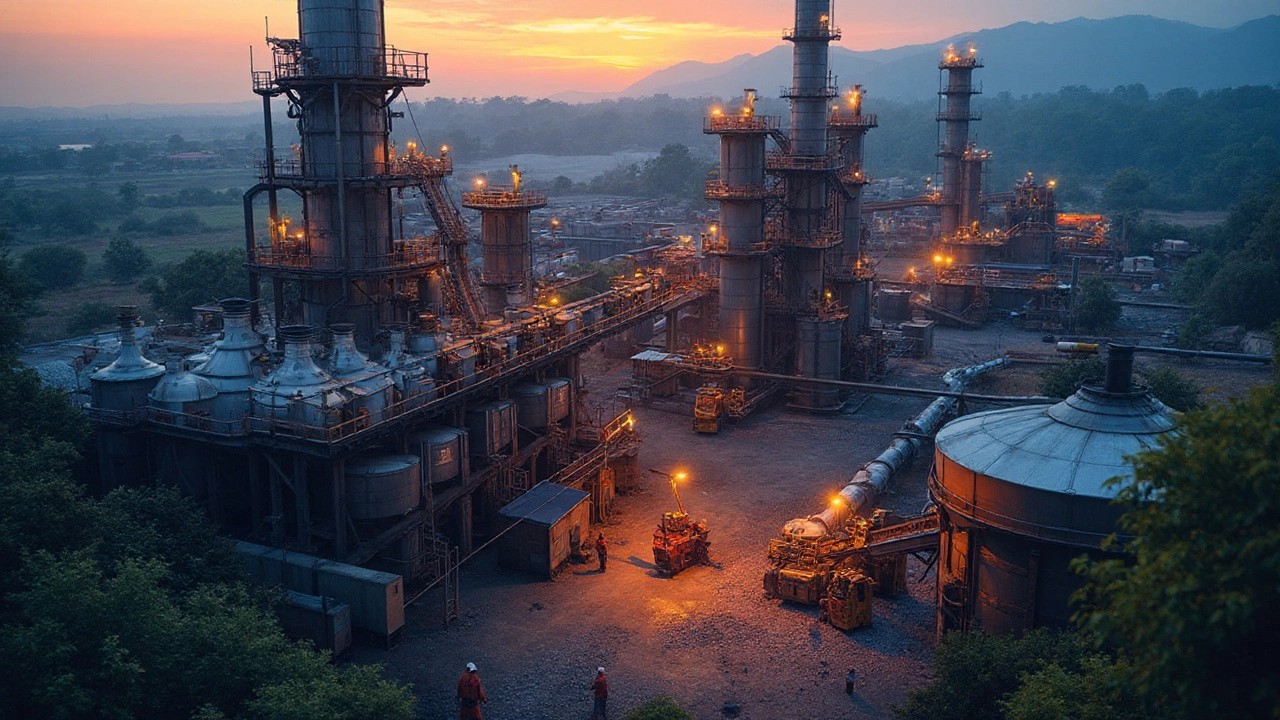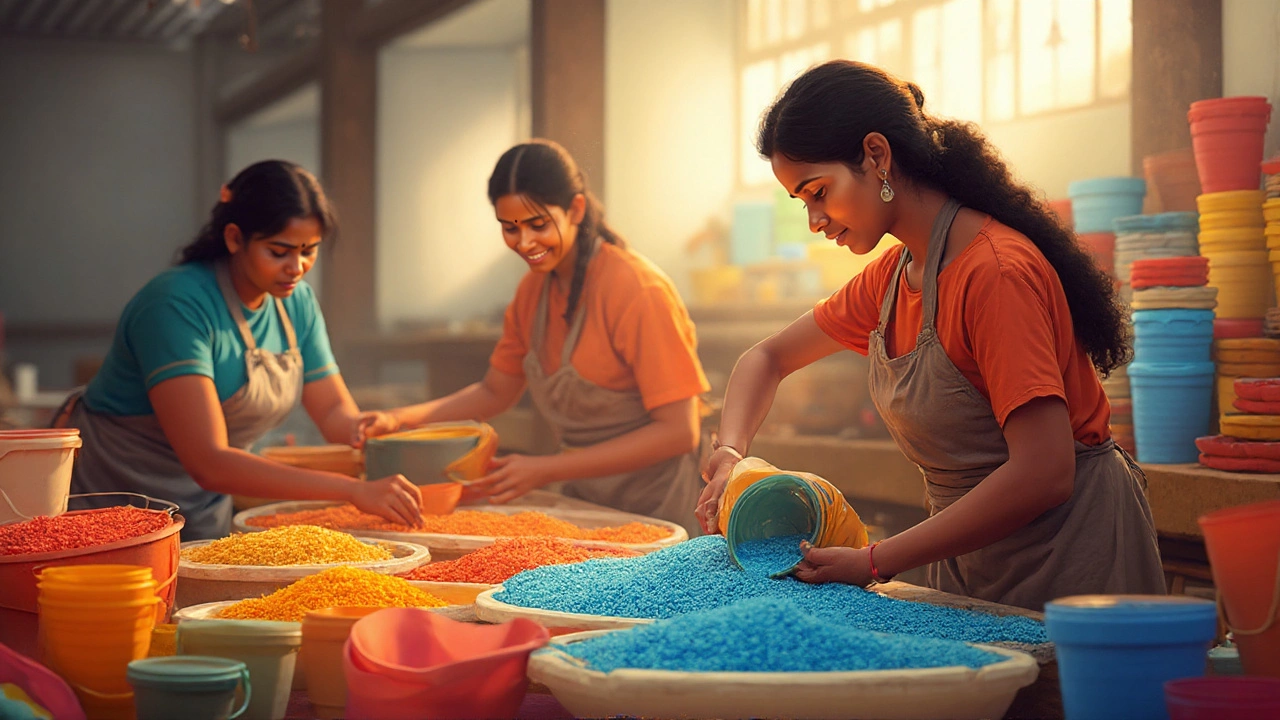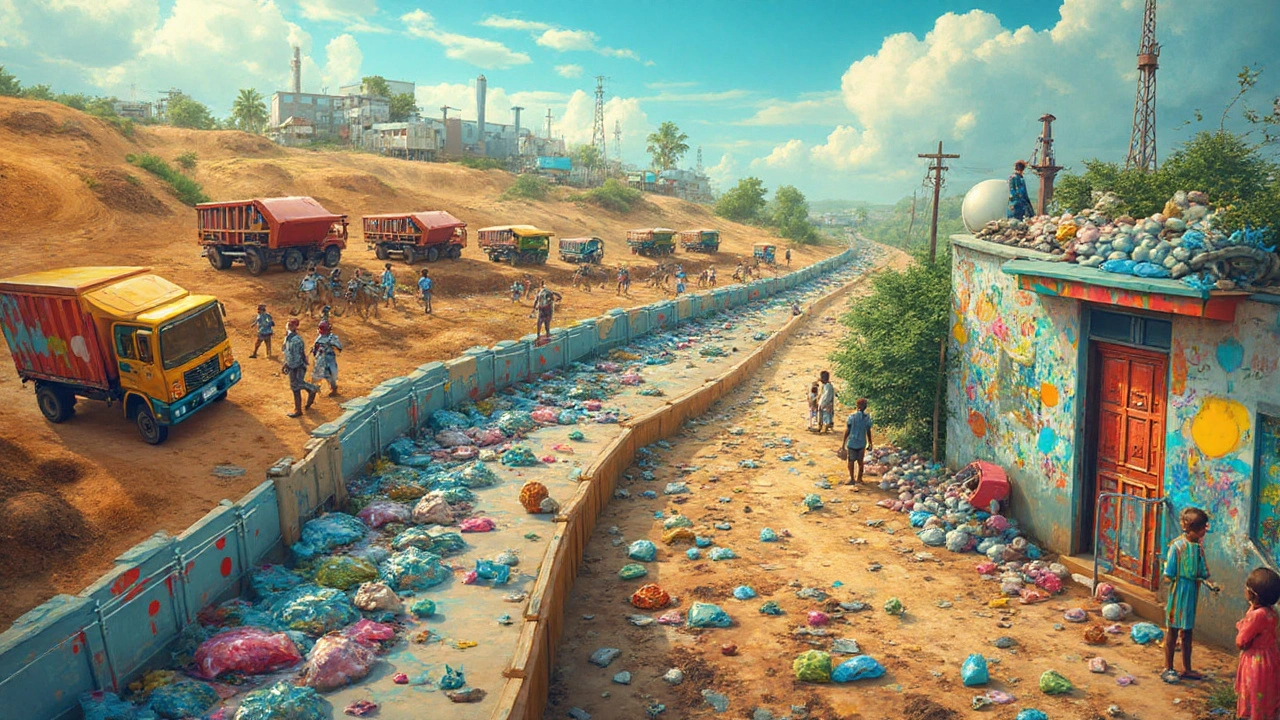 Aug, 5 2025
Aug, 5 2025
Picture this: every day, hundreds of factories across the world churn out plastic products faster than you can finish your morning coffee. From your smartphone case to the pipes buried below Manchester's streets, it’s all plastic everywhere. But nobody really talks about where manufacturers get their plastic. People might imagine there’s a magic plastic tap somewhere, but if you step behind the scenes, the story is a blend of chemistry, logistics, and high-stakes business moves.
The Birth of Plastic: Where Does It Really Start?
Let’s bust one myth straight away—manufacturers don’t dig plastic out of the ground. Most plastic starts life as crude oil or natural gas, and here’s where it gets fascinating. Big oil companies like Shell, ExxonMobil, and BP aren’t just pumping fuel; they’re also producing the building blocks for plastic. More specifically, it’s all about molecules like ethylene, propylene, and styrene. These get pulled from oil and gas through a process called cracking (imagine supercharging oil until its molecules unravel and break apart). Cracking plants exist all over the world, but the biggest hot spots are the USA, China, Saudi Arabia, and Singapore, because those are the world’s best at turning black, sticky oil into colorless, odorless gasses—ready to be built up into plastics.
What happens next is pure alchemy. All those simple molecules get pieced together into long chains, like beads on a string. Suddenly, you’ve got polymers: polyethylene, polypropylene, polystyrene, and a few fancier ones if you want plastics to be heat-resistant or flexible. These polymers aren't really useful yet—they look like white, rice-sized pellets. But they’re easy to ship, store, and transform later.
Why not skip oil and use something else? Well, you can. Some companies are making eco-plastics from sugarcane or corn, but these “bioplastics” are still a tiny slice of the world’s supply (less than 2% according to 2024 industry stats). Oil-based plastics still rule the day, mostly because they’re cheap, predictable, and you can get them anywhere.
Global Supply Chains: The Plastic Highway
No manufacturer worth their salt just walks into a shop for a bag of pellets. The journey from a petrochemical plant to the factory floor is a wild one, involving shiploads of plastic bouncing around half the globe. Most pellets are loaded into massive shipping containers at ports near the refinery. If you could peek inside, you’d see mountains of little white beads, sometimes dyed, sometimes pure as snow.
Take Manchester for example. Local plastic makes up almost none of the supply, even though there’s decades of manufacturing history here. The city’s factories order bulk plastic pellets from European hubs like Antwerp or Rotterdam, or sometimes direct from Asia. An average UK injection-moulding company orders 100 tons at a time, usually negotiating prices way in advance to beat wild fluctuations (the price of plastic is crazy volatile—one month it’s dirt cheap, the next it’s double due to a supply hiccup or spike in oil prices).
Middlemen play a monster role. Resin traders and distributors handle shipments, split containers into smaller lots, offer technical support, and sometimes help with recycling logistics. Think of them as the Amazon Prime for plastic, minus the smiley logo. In 2023, more than 350 million tons of plastic moved through these supply chains, according to the PlasticsEurope industry association.
| Plastic Resin Type | Main Source Region | Common Uses | Global Share (%) |
|---|---|---|---|
| Polyethylene (PE) | USA, China, Middle East | Bags, bottles, piping | 34 |
| Polypropylene (PP) | Asia, Middle East | Packing, automotive, textiles | 27 |
| Polystyrene (PS) | Europe, Asia | Packaging, cutlery, toys | 8 |
| Polyvinyl Chloride (PVC) | China, USA, Europe | Pipes, window frames | 16 |
| Others | Worldwide | Specialty applications | 15 |
Here’s a little insider tip—smart manufacturers always have a plan B, and usually a plan C too. When a ship went sideways in the Suez Canal in 2021, suddenly plastic shipments got stuck, and hundreds of UK companies nearly ran out of stock. If something bad happens to your plastic pipeline, you’d better have a backup supplier on speed dial. Sometimes, bigger companies even buy direct from the chemical giant, skipping distributors, but that usually takes deep pockets and huge warehouses.

Manufacturers’ Hunting Grounds: Buying Plastic Like a Pro
Where does a factory actually buy its plastic? If they’re small, it’s usually through a distributor—someone who has stock ready to go, offers samples, technical advice, and flexible payment. These are the supermarkets of the plastic world. Big names in Europe include Ultrapolymers and Nexeo Plastics, plus dozens of smaller regional players.
Bigger manufacturers—think auto parts for Ford or the guy making Lego bricks—tend to lock in contracts directly with the resin makers, signing deals for thousands of tonnes a year. Sometimes they even influence exactly what’s in the polymer, custom-tweaking it for colour, strength, flame resistance, or recycled content. The actual handshakes happen at industry trade shows or at the resin company’s own offices. When I was in the business, my mate Sam told me about meeting with three major suppliers in one week—flying from Manchester to Belgium to Slovenia, and returning with over 100 pages of sample specs. And yes, sometimes those deals mean signing away your weekends just to make sure the supply keeps flowing.
Don’t forget the niche players. Specialty plastics like those you see in bulletproof glass or medical devices? Often, those are sourced from a handful of top-secret suppliers. These deals are done quietly. A good question manufacturers always ask their supplier: 'How quickly can you deliver if I suddenly double my order?'
If you want to spot a smart manufacturer, look at how many suppliers they have. Relying on only one is risky; splitting orders means fewer headaches if a shipment gets delayed or a price suddenly spikes. Emily reminded me once about a factory she used to work at—when their one and only supplier missed a delivery, production stopped and people were sent home. Bad day for everyone. Diversification isn’t just for stocks, it’s also for plastic supply chains.
Beyond Virgin Plastic: Recycling and Circular Supply
Not all new plastic products come straight from virgin resin. In 2024, about 10% of the global plastic supply came from recycled material, with Europe leading the way. The hot trend is mechanical recycling, where used plastic (think old bottles, crates, or car parts) is chopped, melted, and reformed into new pellets. This material isn’t perfect for every product, but it’s getting better all the time because of newer, high-tech sorting and cleaning systems.
Here’s the practical bit: if you’re a manufacturer making, say, outdoor furniture, nothing beats using recycled high-density polyethylene (HDPE)—it’s tough and cheap, plus you can brag about being green. But recycling brings its own headaches. Supply isn’t always reliable (there’s still not enough collected plastic), colours are tricky to match, and sometimes the quality is worse than virgin resin. Smart manufacturers always test recycled lots before mixing them into production because you don’t want a batch of pink lawn chairs instead of blue ones.
Chemical recycling—a new process that zaps plastic with heat or solvents to break it down into its basic molecules—is gaining traction, especially for tough-to-recycle plastics like food wrappers. Companies like Plastic Energy in Spain and Agilyx in the USA are rolling out these plants, promising to turn rubbish back into near-virgin plastic. It’s expensive, but it’s growing, and in a decade it might be just as common as mechanical recycling.
Manufacturers are starting to chase after 'circularity.' That means collecting old products and making new ones out of them—a sort of boomerang supply chain. It sounds simple but it’s actually a headache to organize logistics, sorting, and consistent quality. Still, with pressure from regulators, big brands, and—let’s be honest—shoppers who care which bin their bottle lands in, recycled plastic is slowly eating into virgin plastic’s dominance.

Plastic Sourcing Tips and Surprising Truths
Want to buy plastic like a pro? The first rule is: timing is everything. If oil prices are low, plastic is too—so some manufacturers bulk buy when the market dips, filling every warehouse corner they have. The second rule: never trust that your supplier will always deliver fast. Always keep some extra stock as a 'rainy day reserve' (most factories that don’t end up regretting it at some point).
Look out for material certifications. If your product touches food or gets sold in the USA, you need plastic that’s FDA-approved. For industries like medical or aerospace, quality standards are sky-high. Forgetting certification can torpedo a whole production run. Another key tip—sometimes 'off-spec' plastic is almost as good as the perfect material, but can be had for 30% less. One factory in Oldham switched to using off-spec resin for making cable sleeves and saved enough to buy a second-hand delivery lorry in just six months.
Surprised by how much negotiating goes into plastic deals? Most prices aren’t set in stone. Bargaining is part of the game—on volume, on delivery speed, even on emergency orders. I've seen manufacturers throw in a signed football shirt or two as a 'sweetener.'
Finally, it’s worth knowing who’s in control of the pipeline. Major plastic resin makers—like Dow, SABIC, and LyondellBasell—wield huge power. If you’re small fry, you won’t have much say in market prices, but joining a buying co-op or industry group can help you get noticed. It’s all about relationships. Good rapport with your supplier can mean getting the rare last shipment when everyone else is out of luck.
The journey from a lump of oil to your favorite garden chair is anything but dull. Sourcing plastic is part detective work, part logistics, a touch of chemistry, and a lot of hustle. The next time you snap a plastic bottle, just remember—it’s taken a bigger journey than most people ever will.